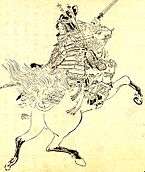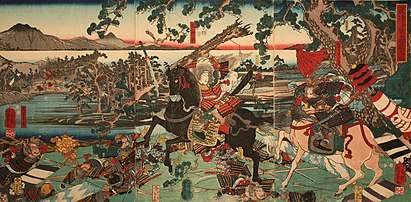Tomoe Gozen
Tomoe Gozen (巴 御前 [tomo.e], c. 1157 – c. 1247[3]) was a late twelfth-century Japanese onna-bugeisha warrior and military leader.[4] She served Minamoto no Yoshinaka during the Genpei War and was a part of the conflict that led to the first shogunate.[5][6] Her family had strong affiliations with Yoshinaka. Her father, Nakahara Kanetō was a strong supporter of Yoshinaka and also his foster father, who raised him since he was two. Her mother was Yoshinaka's wet nurse. Two of her elder brothers also served Yoshinaka as generals.[6] She is best known for her participation in the Battle of Awazu in 1184.
Tomoe Gozen | |
|---|---|
巴 御前 | |
 Tomoe Gozen, a drawing by Shitomi Kangetsu (1747–1797) | |
| Born | circa 1157 |
| Died | circa 1247 Japan |
| Resting place | Otsu City , Kiso Village, Japan |
| Occupation | onna-bugeisha |
| Years active | late 12th century (Heian period) |
| Children | Yoshitaka (ja:源義高 (清水冠者), Yoshishige ?, Yoshimoto ((ja:源義基 (木曾義基)) ? [1][2], Yoshimune (ja:木曾基宗)? |
| Parent(s) | Father = Nakahara no Kaneto (ja:中原兼遠), Mother = Chizuru Gozen (ja:千鶴御前) |
Due to her fierce determination as a warrior, she influenced several generations of samurai. Tomoe is often celebrated in books, music, poems, films, historical novels and popular culture in general. [6]
History
According to epic account written at the beginning of the 14th century,
Tomoe was especially beautiful, with white skin, long hair, and charming features. She was also a remarkably strong archer, and as a swordswoman she was a warrior worth a thousand, ready to confront a demon or a god, mounted or on foot. She handled unbroken horses with superb skill; she rode unscathed down perilous descents. Whenever a battle was imminent, Yoshinaka sent her out as his first captain, equipped with strong armor, an oversized sword, and a mighty bow; and she performed more deeds of valor than any of his other warriors.
In 1182 she commanded 300 samurai in a struggle against 2,000 warriors of the rival Taira clan. After defeating the Taira and driving them into the western provinces, Yoshinaka took Kyoto and desired to be the leader of the Minamoto clan. His cousin Yoritomo was prompted to crush Yoshinaka, and sent his brothers Yoshitsune and Noriyori to kill him. Yoshinaka fought Yoritomo's forces at the Battle of Awazu on February 21, 1184, where Tomoe Gozen purportedly took at least one head of the enemy. Although Yoshinaka's troops fought bravely, they were outnumbered and overwhelmed. When Yoshinaka was defeated there, with only a few of his soldiers standing, he told Tomoe Gozen to flee because he wanted to die with his foster brother Imai no Shiro Kanehira and he said that he would be ashamed if he died with a woman.[8]

There are varied accounts of what followed. At the Battle of Awazu in 1184,[9] she is known for beheading Honda no Morishige of Musashi.[10] She is also known for having killed Uchida Ieyoshi and for escaping capture by Hatakeyama Shigetada.[11] After Tomoe Gozen beheaded the leader of the Musashi clan and presented his head to her master Yoshinaka, Tomoe's reputation was so high that she was considered the first general of Japan.[12]
In fiction and culture
- Tomoe Gozen's life, set in a fantasy Japan, is the subject of a trilogy of novels by Jessica Amanda Salmonson (The Disfavored Hero, The Golden Naginata and Thousand Shrine Warrior, 1981–1984).
- Tomoe Gozen is the basis of the Persona of Chie Satonaka in the 2008 video game Persona 4.
- Tomoe Gozen is a playable commander in the Rise of Kingdoms online game, with an archery & support specialization.[13]
- Tomoe Gozen is one of the supporting characters in the 2010 Syfy series Riverworld.
- Tomoe Gozen appears as an enemy at first with her alias as 'Archer of Inferno', but becomes a playable Archer-class servant in the mobile game Fate/Grand Order.
- A character based on Tomoe Gozen appears in the Stan Sakai comic book series Usagi Yojimbo, named Tomoe Ame.
- Tomoe Gozen appears as a character in the podcast Film Reroll.
- Tomoe Gozen appears as a character in the manga and anime Nurarihyon no Mago.
- Tomoe Gozen appears in Heian Shrine's Jidai Matsuri (Festival of the Ages), which is held on October 22 each year.
- Tomoe is mentioned in Sekiro: Shadows Die Twice as the mentor of one of the primary antagonists, Genichiro Ashina, who taught him how to harness the power of lightning. She is described as a swordswoman of remarkable skill. Whether or not the mentioned Tomoe is in fact Tomoe Gozen is not clarified though
- Tomoe Gozen appears in the Samurai Deeper Kyo manga by Akimine Kamijyo (1999-2006), where she initially appears as Saisei, until it is revealed she is Tomoe Gozen, but resurrected as a zombie to help the antagonists.
- Tomoe Gozen is mentioned in the Miraculous: Tales of Ladybug & Cat Noir series, where she is revealed to be a past Miraculous holder.
- A character named Tomoe is featured in Ghost of Tsushima, inspired by Tomoe Gozen. [14]
Gallery
 Tomoe Gozen—artist's impression by Kikuchi Yōsai (1781–1878)
Tomoe Gozen—artist's impression by Kikuchi Yōsai (1781–1878) Tomoe Gozen in the Battle of Awazu—by Utagawa Yoshikazu
Tomoe Gozen in the Battle of Awazu—by Utagawa Yoshikazu
 Tomoe Gozen at the Yodo River—by Toyohara Chikanobu (1838–1912)
Tomoe Gozen at the Yodo River—by Toyohara Chikanobu (1838–1912) Tomoe Gozen defeats Uchida Saburō—by Tsukioka Yoshitoshi (1839–1892)
Tomoe Gozen defeats Uchida Saburō—by Tsukioka Yoshitoshi (1839–1892) Memorial to Tomoe at Gichū-ji, Ōtsu, Shiga Prefecture
Memorial to Tomoe at Gichū-ji, Ōtsu, Shiga Prefecture
Notes
- ja:武居用拙『岐蘇古今沿革志』(明治23年(1890年))
- ja:今井善兵衛著『更生農村 : 北橘村の実情 』日本評論社(1935年)
- Note: Gozen is not a name, but rather an honorific title, usually translated to "Lady", though the title was rarely bestowed upon men as well.
- Nussbaum, Louis Frédéric et al. (2005). "Tomoe Gozen" in Japan Encyclopedia, p. 984., p. 984, at Google Books
- Turnbull, Stephen (1987). Battles of the Samurai. Arms and Armour Press. p. 14. ISBN 978-0853688266.
- Pennington, Reina (2003). Amazons to Fighter Pilots - A Biographical Dictionary of Military Woman (Volume Two). Westport, Connecticut: Greenwood Press. pp. 437–438. ISBN 978-0-313-32708-7.
- McCullough, Helen Craig. (1988). The Tale of the Heike, p. 291., p. 291, at Google Books; Kitagawa, Hiroshi et al.(1975). The Tale of the Heike, p. 519.
- The Tales of the Heike. Translated by Burton Watson. Columbia University Press. 2006. p. 86. ISBN 9780231138031.
- Turnbull, Stephen (1998). The Samurai Sourcebook. Cassell & Co. p. 204. ISBN 978-1854095237.
- Faure, Bernard. (2003). The Power of Denial: Buddhism, Purity, and Gender, p. 211, p. 211, at Google Books; Kitagawa, p. 521.
- Joly, Henri L. (1967). Legend in Japanese Art, p. 540.
- Salmonson, Jessica Amanda (2015-04-07). Thousand Shrine Warrior. Open Road Media. ISBN 9781453293836.
- "Rise of Kingdoms Commander Tomoe Gozen". Rise of Kingdoms Guides. Retrieved 2020-07-13.
- Tassi, Paul. "'Ghost Of Tsushima 2' Has A Clear Hero In Waiting, A Legendary Woman Samurai". Forbes. Retrieved 2020-07-30.
References
- Faure, Bernard (2003). The Power of Denial: Buddhism, Purity, and Gender. Princeton: Princeton University Press. ISBN 978-0-691-09170-9; ISBN 978-0-691-09171-6; OCLC 49626418.
- Joly, Henri L. (1967). Legend in Japanese Art: A Description of Historical Episodes, Legendary Characters, Folk-lore Myths, Religious Symbolism, Illustrated in the Arts of Old Japan. Rutland, Vermont: Tuttle. ISBN 978-0-8048-0358-8; OCLC 219871829.
- Kitagawa, Hiroshi and Bruce T. Tsuchida, ed. (1975). The Tale of the Heike. Tokyo: University of Tokyo Press. ISBN 0-86008-128-1; OCLC 164803926.
- McCullough, Helen Craig (1988). The Tale of the Heike. Palo Alto, California: Stanford University Press. ISBN 978-0-8047-1418-1; OCLC 16472263.
- Nussbaum, Louis Frédéric and Käthe Roth (2005). Japan Encyclopedia. Cambridge: Harvard University Press. ISBN 978-0-674-01753-5; OCLC 48943301.
Miraculous Ladybug(2019)Ikari Gozen
External links
| Wikimedia Commons has media related to Lady Tomoe. |
- Famous Women of Japanese History. The Samurai Archives Japanese History Page.
- Shea, L. "Tomoe Gozen - Female Samurai". Bella Online, 2009.